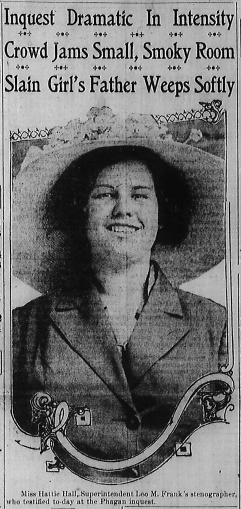
Miss Hattie Hall, Superintendent Leo M. Frank’s stenographer, who testified to-day at the Phagan inquest.
Another in our series of new transcriptions of contemporary articles on the Leo Frank case.
Atlanta Georgian
Thursday, May 8th, 1913
Crowd in Small, Smoke-Filled Room Breathlessly Follows the Phagan Slaying Inquiry.
FATHER WEEPS SILENTLY
Jurors, Officials and Detectives Manifest Intense Interest in Replies of Witnesses.
In a small, crowded and smoke-filled room at police headquarters, Coroner Donehoo on Thursday morning began what it is thought will be the last session of the jury impaneled to inquire into the death of Mary Phagan, strangled to death in the basement of the National Pencil Factory April 26.
The situation was tense and pregnant with possibilities. The fact that the investigation of the case is rapidly drawing to a close, coupled with the admissions of officials that new and important evidence would develop the examination of the witnesses to-day, brought out a large and curious crowd.
At one end of the long table, heaped with notebooks and typewriters, sat Coroner Donehoo, flanked on each side by members of the jury. At the foot of the table sat the newspaper reporters and the official stenographers, four in number. Facing Coroner Donehoo and the jury sat the witness. Ranged along the wall were curious spectators, relatives of the dead girl and friends of the witnesses. Long before the inquest was called every available chair in the room was taken, and late comers ensconced themselves on the window ledges.
Dorsey Takes Active Part.
Prominent among the spectators were the attorneys for Frank, Pinkerton and city detectives and county and State officials. Solicitor Hugh Dorsey sat just behind Coroner Donehoo, and took an active part in the questioning of the witnesses. While Mr. Dorsey asked no questions himself, several times he conferred with the Coroner on the best manner in which to examine the witnesses.
Attorney Luther Rosser also occupied a seat near the Coroner, and took keen interest in the proceedings of the inquest. He did not object to any of the questions asked the witnesses that had bearing on the actions of Leo M. Frank on the day of the murder.
Ranged against the wall behind Coroner Donehoo were Detective John Black, in charge of the city investigating squad; Detective Starnes, and Detective Harry Scott of the Pinkertons. All of the officers paid close attention to the examination of the witnesses. To the left of the Coroner sat Dr. J. W. Hurt, County Physician, who examined the body, and whose testimony is awaited with considerable curiosity.
Father a Pathetic Figure.
J. W. Coleman, father of the dead girl, stood against the wall to the right of Coroner Donehoo, a pathetic figure in his sorrow. Mr. Coleman evinced keen interest in what was transpiring. He kept his eyes fixed constantly on the witness who sat at the foot of the long table, and his eyes filled with tears as the tragic details of the finding of the child’s body were related.
The attitudes of the individual members of the jury showed their realization of the responsibility that rests upon them. Each of the six sat with his arms on the table, paying closest attention to the statements of the witnesses. Most of the questions were asked by the Coroner, but now and then a juror would interrupt to ask the witness to make some point clearer.
The air of tense eagerness with which the jurors awaited the replies of the witnesses was communicated to those whose only interest in the case was the satisfaction of curiosity.
Crowd Tense and Quiet.
The crowd in the room was one of the quietest that has ever attended a session of the inquest. Save for the occasional scratching of a match or the dragging of a chair across the floor, nothing was heard but the voices of the Coroner and the witnesses.
All of the witnesses brought in were subjected to a close examination by Coroner Donehoo, and all bore the ordeal well. “Boots” Rogers, one of the policemen who found the body, was on the stand more than an hour.
* * *
Atlanta Georgian, May 8th 1913, “Inquest Scene is Dramatic in its Tenseness,” Leo Frank case newspaper article series (Original PDF)
